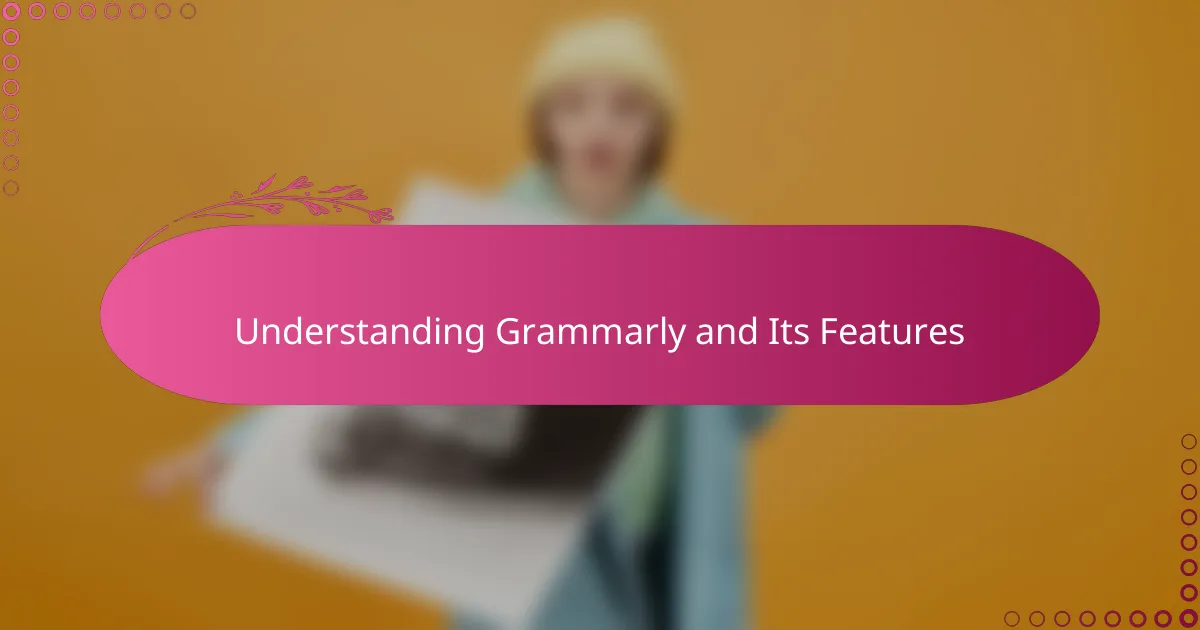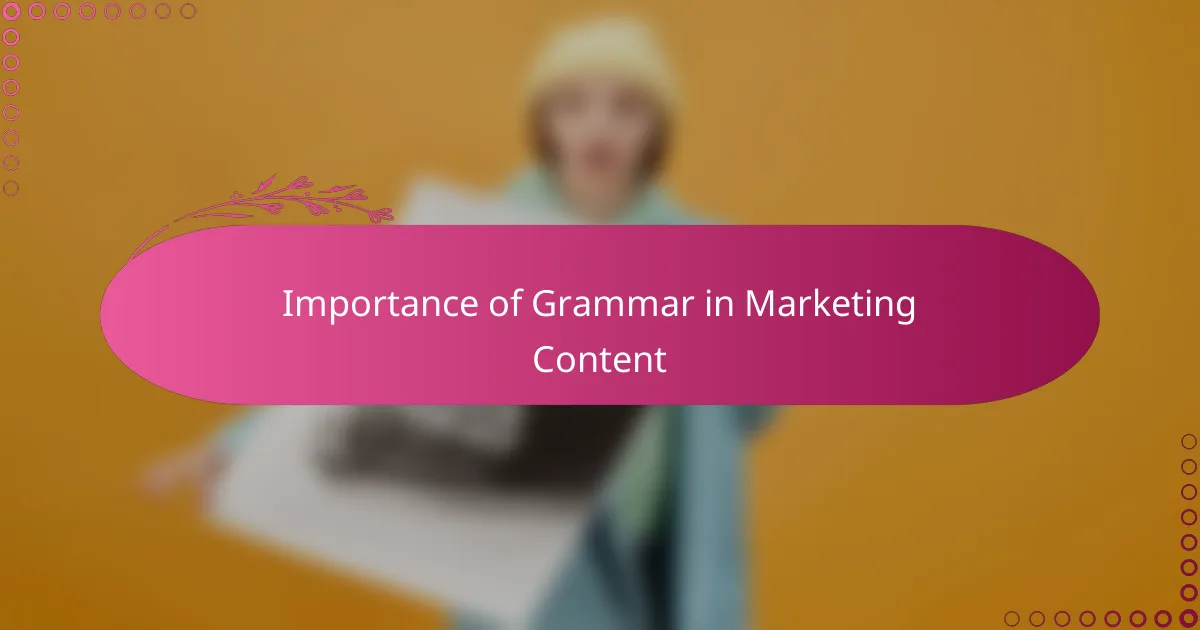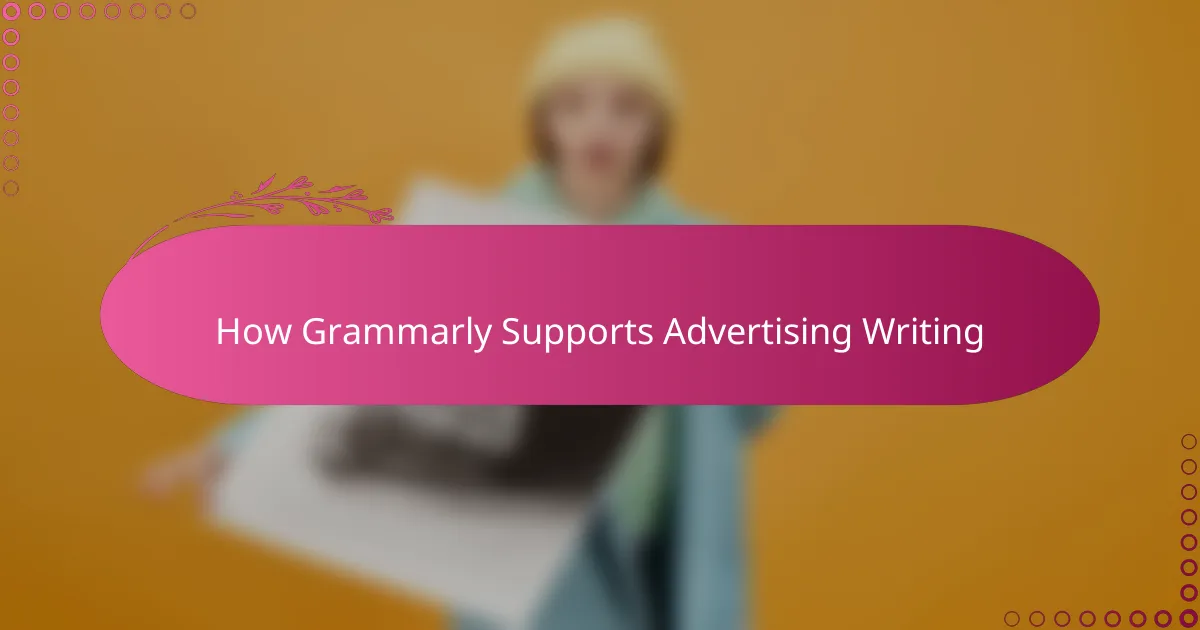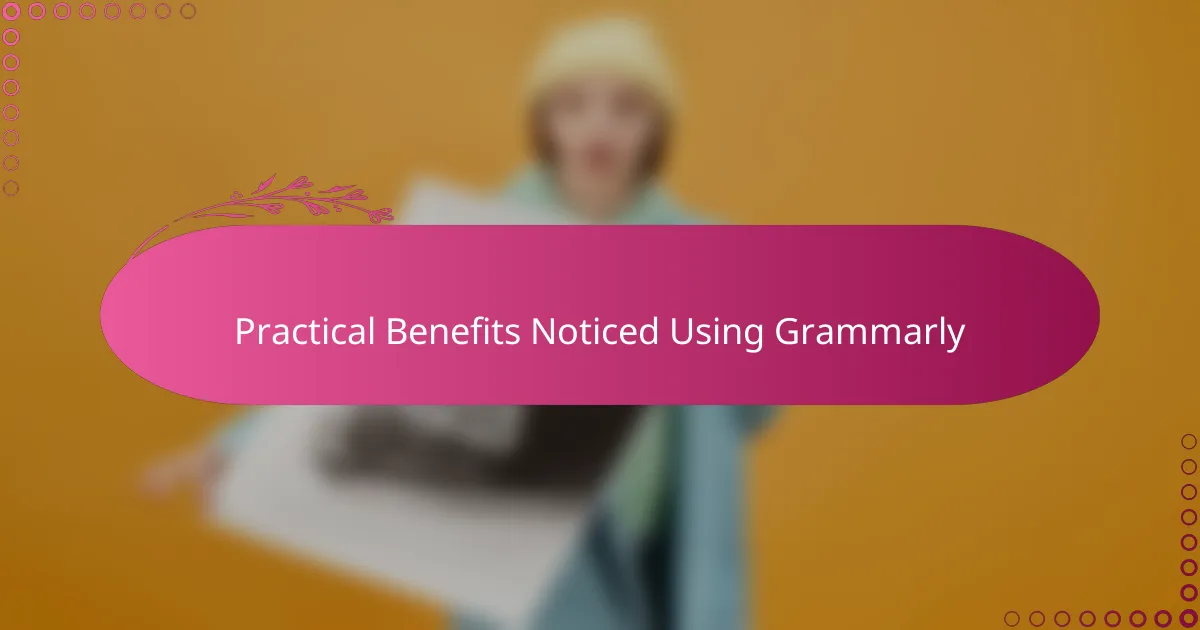Key takeaways
- Grammarly enhances writing by providing personalized suggestions that adapt to different tones and styles, improving clarity and impact.
- Proper grammar in marketing content boosts credibility and engagement, ensuring messages resonate with the audience.
- Customization features allow users to tailor Grammarly for specific writing needs, making it a more effective tool for varied projects.
- While Grammarly is helpful, it may struggle with creative writing styles and specialized terminology, highlighting the importance of user input.

Understanding Grammarly and Its Features
Grammarly, in my experience, goes beyond simple spell-checking. It’s like having a personal editor who gently points out not only mistakes but also suggests clearer, more impactful ways to express your ideas. Have you ever found yourself stuck, wondering if a sentence truly conveys your message? Grammarly often provided that nudge I needed.
One feature I particularly appreciate is its ability to adapt suggestions based on the type of writing I’m doing—whether it’s casual marketing copy or a polished report. This flexibility felt like the tool really understood my voice, making the editing process less mechanical and more intuitive. It’s almost as if Grammarly learns alongside you, which I find incredibly helpful when working under tight deadlines.
Finally, the tone detection caught me off guard at first. It made me pause and think: Is my writing coming across as confident, friendly, or formal enough for the audience? This feature pushed me to be more conscious about how my words land, a subtle but powerful way to enhance connection with readers in marketing and advertising contexts.

Importance of Grammar in Marketing Content
Grammar shapes the first impression your marketing content leaves. Have you ever skimmed through an ad and instantly tuned out because something felt “off”? That’s often the subtle impact of poor grammar—something I’ve noticed firsthand when a simple mistake undermined an otherwise strong message. It’s not just about correctness; it’s about credibility.
I’ve experienced how polished grammar elevates brand trust. When every sentence flows smoothly and clearly, readers are more likely to engage and even convert. It’s like speaking to your audience with confidence and professionalism—qualities you simply can’t fake in marketing material.
But beyond professionalism, good grammar clarifies your message. Marketing content aims to persuade, inform, and inspire action, and muddled sentences can kill that momentum. Don’t you want your audience to understand your offer the first time they read it? I certainly do, and grammar plays an essential role in ensuring that happens.

How Grammarly Supports Advertising Writing
When I started using Grammarly for my advertising writing, I quickly noticed how it helped sharpen my headlines and taglines. It’s not just about catching typos; the tool suggests punchier alternatives that make the message pop—something every advertiser craves. Have you ever struggled to find that perfect phrase that grabs attention instantly? Grammarly made that process less daunting for me.
One aspect I value is how Grammarly flags overused words or clichés, pushing me to be more creative and original. In advertising, standing out is everything, and having a tool that gently warns me when I’m slipping into tired expressions has saved me from sounding repetitive. It’s like having a fresh pair of eyes that cares about keeping your copy vibrant and engaging.
Grammarly’s readability insights also helped me tailor my ads more thoughtfully. I realized that simplifying complex sentences made my messages clearer and faster to digest, which is crucial for catching busy consumers’ attention. Isn’t it frustrating when you pour effort into an ad only to wonder if people will actually read it? With Grammarly, I felt more confident that my writing was both compelling and accessible.

My Setup and Customization Experience
Setting up Grammarly was surprisingly straightforward, but what really caught my attention was the level of customization available right from the start. I remember tweaking the language preference and choosing the type of English I write in—American or British—which made me feel like the tool was tailored just for me. Have you ever come across software that actually fits your style without much hassle? This was exactly that experience.
What impressed me more was configuring the writing goals. I selected audience type, formality, and intent, which instantly changed the nature of Grammarly’s suggestions. It felt like having a writing coach who knows exactly what your project demands, whether it’s a casual blog post or a formal marketing pitch. That little adjustment made a big difference in how the edits felt relevant and practical.
I also played around with the personal dictionary, adding brand names and industry jargon to avoid constant false flags. At first, I was skeptical if this would be worth the time, but it saved me from tedious corrections down the line. Have you tried customizing a tool so it understands your unique language quirks? For me, this feature turned Grammarly from a generic assistant into a truly personalized writing partner.

Practical Benefits Noticed Using Grammarly
One practical benefit I immediately noticed was how Grammarly saved me time by catching errors before I hit “send.” Instead of going back and forth with colleagues or second-guessing my drafts, I felt more confident that my writing was clean and professional from the start. Have you ever felt that relief when a tool actually lightens your workload? That was a game changer for me.
Another upside was the clarity boost Grammarly provided. It nudged me to simplify complex sentences, which made my marketing messages sharper and more persuasive. I realized that even small tweaks suggested by the tool could greatly enhance how my audience received the content. Isn’t it satisfying when your words click perfectly with your readers?
Lastly, Grammarly’s consistency checks helped maintain my brand’s voice across different pieces of content. I no longer worried about subtle tone shifts or awkward phrasing sneaking in. It’s like having a silent partner ensuring everything sounds on point, which made my advertising copy feel more polished and trustworthy. Have you ever experienced that extra layer of confidence knowing your writing truly represents your brand? That was exactly how I felt.

Challenges and Limitations Faced
Sometimes Grammarly’s suggestions didn’t quite fit the tone I was aiming for, especially in more creative or playful marketing copy. Have you ever felt that a tool’s fixes made your text sound too stiff or generic? That tension between automated advice and my personal style was a real challenge.
Another limitation I noticed was that Grammarly occasionally flagged specialized marketing jargon or brand names as errors before I adjusted the personal dictionary. At first, those repeated ‘false alarms’ were frustrating and interrupted my workflow. It made me realize that even the best tools need some user input to truly align with niche industry language.
Lastly, Grammarly’s free version, while helpful, sometimes felt restrictive, especially when I needed deeper insights into tone or structure. Have you ever wished for that extra level of editing without immediately committing to a paid plan? I definitely experienced that pull between wanting thorough feedback and managing resources on tight marketing budgets.